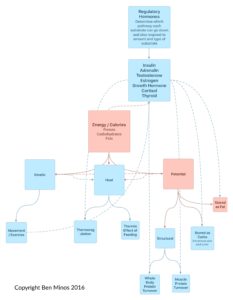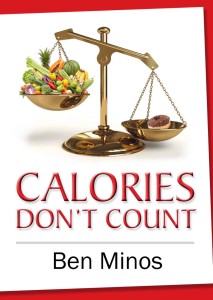Why “Energy In Energy Out” Doesn’t Tell You If You Will Get Fat
The laws that govern whether or not you lose or gain fat is more than just an energy equation.
When it comes to storing and losing fat: It’s not just about a calorie surplus. It’s not just about calorie deficit.
Still, to this day, even so many so called experts can’t seem to get their head around this concept.
And still. Still, so many seemingly educated people will try and have you believe the only way you can lose fat is with a calorie deficit and the only way you can gain fat is with a calorie surplus.
Even though I’ve tried to explain this concept in detail over the years, it seems like people still don’t seem to “get it”. They think that as soon as you mention this, you somehow don’t believe in the laws of thermodynamics and conservation of energy. Or they think you peddle pseudo science like “you can eat as much fat as you like as long as you get rid of sugar”. Nothing could be further from the truth.
Hopefully, this chart can simplify the whole picture (yeah right) and break it down to be less confusing.
I’ve always been a visual learner. The whole process is obviously extremely complex. But I always find it easier to break things down into its simplest principle. This flow chart breaks everything down and summarises the whole process as simply as possible. It’s not comprehensive, but it will hopefully give you the overall picture. Sometimes it’s good to adopt a top down approach so you don’t miss the “forest for the trees”.

There are 3 Possible Pathways for the energy you ingest:
It’s an inescapable law of physics, the law of thermodynamics, you can’t create or destroy energy, it can only be converted in to one form or another. The energy of the system, therefore, has to ALWAYS be conserved.
When it comes to the human body, there are 3 possible pathways this “energy” can go down.
The food you eat can be converted to one of the 3 following energy forms:
- Kinetic
- Thermogenic
- Potential
Kinetic energy means it gets used to cause movement
Thermogenic means some of it gets lost as heat during normal cellular processes, maintaining body temperature and also during exercise.
Potential means some of it can get stored, either as structural material or for later use i.e. stored glycogen, stored fat.
Now. Look at these pathways closely again. And look at the “stored fat” pathway. The most important thing to wrap your head around is that the pathway that any “calorie” can go down is not fixed. It is a constantly fluid and shifting process that is influenced by a number of factors. NOT just whether or not there is an excess of energy in the system.
The main factors that influence which pathway any food can flow down is:
- The type of macronutrient – not all macronutrients are capable of going down all of the pathways i.e. Carbohydrates do not serve any structural role. Protein has the highest Thermic Effect of Feeding.
- The amount you eat influences the pathway – the amount of food definitely does matter, but it is not the only influence on which pathway a macronutrient will ultimately travel down
- The hormonal environment influences the pathway – I have written about this extensively before in my Science of Fat Loss series, so I won’t go over it again here. Needless to say, the hormonal environment will influence which pathway the macronutrient is most likely to go down.
- The hormonal environment is influenced by a number of factors including exercise, macro type and amount, recovery and wellness state (illness) of the organism. The whole system works off a feedback system and a complex interaction between all of these factors. Nothing happens in isolation!
- Off the back of that, your “energy in” influences your “energy out”. People talk about metabolism all the time with little to no understanding what it actually means. People seem to accept that you can increase your metabolism by eating more food, but don’t understand how it works. This chart hopefully helps.
- Just because you have an energy surplus DOESN’T automatically mean it will get stored as fat. Just because you have a deficit does not mean it will automatically get pulled from your fat stores. – don’t you think it’s possible that maybe, just maybe you can influence the system to put those extra calories to good use? Or pull that energy deficit from the right places and not muscle? Isn’t that also what calorie counters do anyway? Yes it is. And the very fact they do it also means it’s not just about how many calories they had that day.
In short IT IS NOT A CAUSE AND EFFECT RELATIONSHIP!!!
What the calorie theory gets right:
The laws of thermodynamics, also known as conservation of energy, is an unbreakable law of our physical universe. You can’t create or destroy energy. It can only be transformed in to one form or another. What they don’t get is, you can have conservation of energy of the system. That’s not what we’re actually talking about.
What we’re really talking about is your fat cells specifically. What makes them bigger, what makes them smaller. As you can see by the chart below, for any “energy” to be stored as fat it has to go down a specific pathway. Whether or not a macronutrient goes down this pathway is determined by a number of factors, not just whether or not there is an “energy surplus”.
Problems with the calories theory:
All calories are definitely not created equally. Proteins are processed differently than carbs, which are processed differently than fats. They have different metabolic and hormonal effects and also different thermogenic effects. So, a calorie from carbs is never the same as a calorie from protein.
What the subject should be about is what are the circumstances that cause fat cells to get bigger, what causes them to get smaller. Energy in is NOT the sole determinant for this process to occur
Your Fat Is Not Just A Storage Dump For Excess Calories!
The main concept need to get out of your head is that fat is just a storage dump for extra calories or energy. Your fat cells are in fact an endocrine organ. Which means they release hormones. These influence metabolism and hunger amongst other things. Your fat cells also react to hormones.
Fat cells are under regulatory control. This control is actually exerted by hormones. Not calories. And while it’s true the energy you ingest influences your fat cells. They are not solely governed by it.
But, doesn’t this chart just proves it’s all about energy in energy out?
It’s easy after the event to look back and say “see, when we account for TEF, TEE, NEAT, change in potential energy, etc, we can show what happened” so it must be calories.
The very fact the calorie theory has had to change and adapt over the years every time it has been proven wrong shows it’s actually NOT just about the calories. Concepts such as NEAT (Non Exercise Activity Thermogenesis) have had to enter in to account for areas that didn’t add up. Not to mention that NEAT is influenced itself by the “calories in”.
It’s very easy to look at the system AFTER the fact and say “well see, we used this much for activity, their metabolism increased because of this, their spontaneous activity went up, they stored this much as muscle tissue and this much as muscular glycogen. So, subtract the remainder and…see!!! It’s still just about energy in energy out”.
But that’s like reading stock charts. Everything makes sense AFTER the event. (for anyone who doesn’t get predicting stocks on charts, it’s the finance world version of fortune telling) It does nothing to tell you about the fundamentals of the company. I just realised people would probably get a finance analogy less than a nutrition one, soooooo….
It does NOTHING to influence which pathway these “calories” can go down on the way in. And, again, it shows that just by having a surplus DOESN’T mean it will get stored as fat. Yeah, you can calculate it AFTER the event show where it went. Doesn’t mean you had complete control over it just by counting it on the way in. Which is EXACTLY what the calorie theory is based on.
You can still have conservation of energy. You can still abide by the laws of physics. They’re not the questions we should be asking. What you want to know is what influences your fat levels. And what you can see is that storing body fat is only a small fraction of an overall massive puzzle.
The main thing we are concerned with is dropping stored fat. Take a good look at the diagram closely and see what a tiny fraction of that whole equation it is.
Same when it comes to storing fat. Look at all the possible pathways and also look at all of the regulatory hormones that influence that pathway beyond just a simple “calorie” excess.
Don’t you think maybe. Just maybe the laws of thermodynamics can be adhered to and you can influence body fat levels on not just an energy in / energy out basis?
Having said that, what the hell should you be counting then? Well, only worry about the things you have control over.
Get your macros right. The amount and the quality. Measure them. Count them.
Then measure and assess the results. Adjustments should be made based on the results not just for the sake of having to drop calories.
Whenever you read anything or listen to anything from now on, keep this chart in mind. If they try and make you believe you can somehow circumvent any of these pathways or talk to you in absolutes, you can kindly now scientifically understand how they are simply full of crap.
 Ben Minos has Bachelor degrees in both Physiotherapy and Exercise Science (Human Movements). He has worked as a Personal Trainer for 20 years and a Physiotherapist for close to 15. Ben has authored a book on nutrition titled Calories Don’t Count, available through iBooks, Amazon and most online retailers. He has also authored many articles for Ironman Bodybuilding Magazine and also co authored Australia’s first Kettlebell instructor certification course. He has competed in Natural Bodybuilding over a number of years, as well as prepared numerous clients for the stage.
Ben Minos has Bachelor degrees in both Physiotherapy and Exercise Science (Human Movements). He has worked as a Personal Trainer for 20 years and a Physiotherapist for close to 15. Ben has authored a book on nutrition titled Calories Don’t Count, available through iBooks, Amazon and most online retailers. He has also authored many articles for Ironman Bodybuilding Magazine and also co authored Australia’s first Kettlebell instructor certification course. He has competed in Natural Bodybuilding over a number of years, as well as prepared numerous clients for the stage.